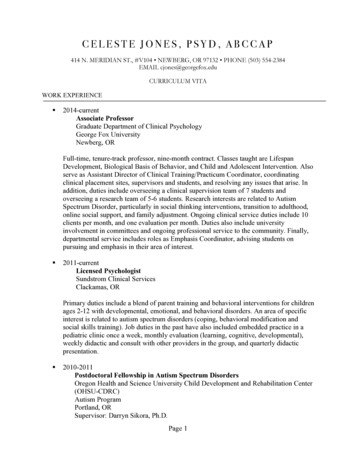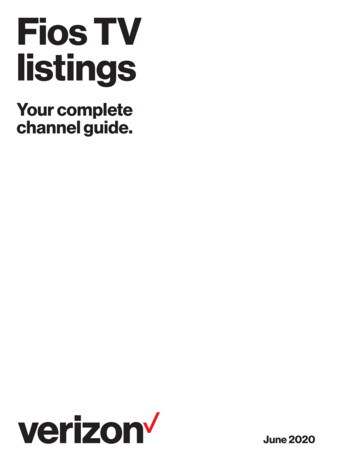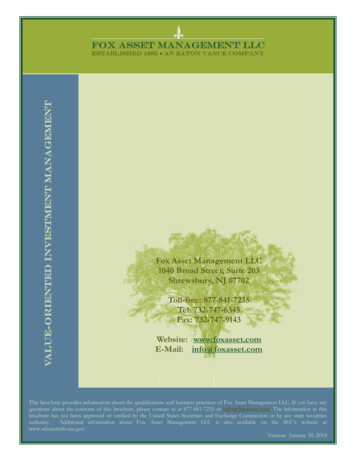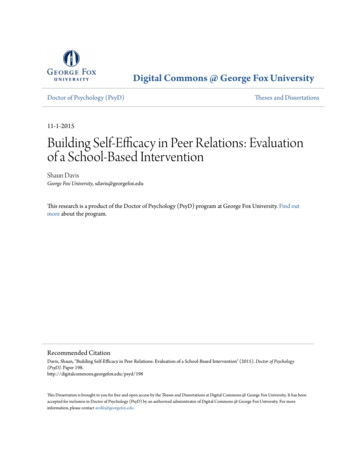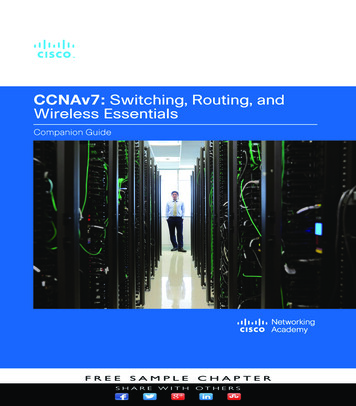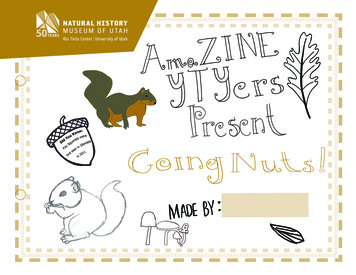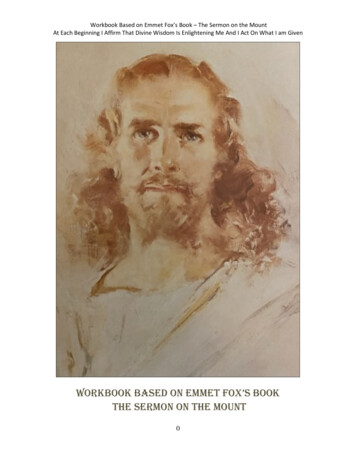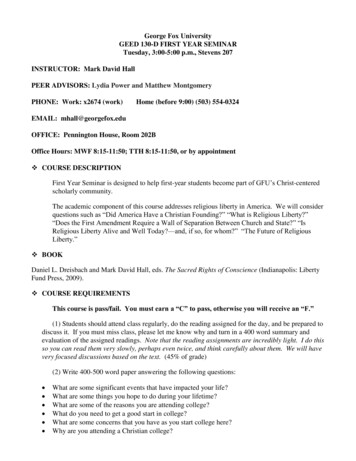
Transcription
George Fox UniversityGEED 130-D FIRST YEAR SEMINARTuesday, 3:00-5:00 p.m., Stevens 207INSTRUCTOR: Mark David HallPEER ADVISORS: Lydia Power and Matthew MontgomeryPHONE: Work: x2674 (work)Home (before 9:00) (503) 554-0324EMAIL: mhall@georgefox.eduOFFICE: Pennington House, Room 202BOffice Hours: MWF 8:15-11:50; TTH 8:15-11:50, or by appointment COURSE DESCRIPTIONFirst Year Seminar is designed to help first-year students become part of GFU’s Christ-centeredscholarly community.The academic component of this course addresses religious liberty in America. We will considerquestions such as “Did America Have a Christian Founding?” “What is Religious Liberty?”“Does the First Amendment Require a Wall of Separation Between Church and State?” “IsReligious Liberty Alive and Well Today?—and, if so, for whom?” “The Future of ReligiousLiberty.” BOOKDaniel L. Dreisbach and Mark David Hall, eds. The Sacred Rights of Conscience (Indianapolis: LibertyFund Press, 2009). COURSE REQUIREMENTSThis course is pass/fail. You must earn a “C” to pass, otherwise you will receive an “F.”(1) Students should attend class regularly, do the reading assigned for the day, and be prepared todiscuss it. If you must miss class, please let me know why and turn in a 400 word summary andevaluation of the assigned readings. Note that the reading assignments are incredibly light. I do thisso you can read them very slowly, perhaps even twice, and think carefully about them. We will havevery focused discussions based on the text. (45% of grade)(2) Write 400-500 word paper answering the following questions: What are some significant events that have impacted your life?What are some things you hope to do during your lifetime?What are some of the reasons you are attending college?What do you need to get a good start in college?What are some concerns that you have as you start college here?Why are you attending a Christian college?
GED 130 B 2This paper should be typed, with your name, date & box number in the upper right hand corner. Youshould form an introduction, body & conclusion. Proofread your paper carefully before turning it in.Points are given for level of consideration of each of the above questions. I would like to see a coherent,thoughtful paper, not a point-by-point response to each question. Due September 8. (10% of grade)(3) Meet with me between September 10 and 21 and with peer advisers twice (ideally, once infirst six weeks and the second sometime after that—but make sure to have both meetings before 11/15)(10% of grade)(4) Complete Semester Map. Due September 15. (5% of grade)(5) Successfully complete all required assignments on Fall 2015 First Year Seminar Calendar(immediately below). (30% of grade)Fall 2015 First Year Seminar CalendarWeek of1. 9/12. 9/13. 9/84. 9/135. 9/176. 9/28-10/27. 9/298. 10/6Library Tour: 3:00-4:00. Meet in lobby of library at 3:00. You mustcomplete the online library tutorial available on foxtale prior to thetour. The library will let me know who successfully completed the onlineand in-library assignments.IDEA Center Presentation (Stevens 207, 4:00 sharp!)Assignments: Complete StrengthsQuest and survey administered by RickMuthiahParticipate in Social ActivityFirst Year Seminar AssemblyMonday, 9/17, 10:50-11:40 a.m., Bauman AuditoriumSuccess at George Fox UniversityMajor connection activity (see last three pages of syllabus for details)Assignment: Complete survey administered by Rick Muthiah.StrengthQuest Essay (see last three pages of syllabus for details)MARK’S TOPICS AND ASSIGNMENTSAugust 28Welcome Weekend Meeting: My apologies, I’m out of town taking my own daughter to college.Mostly introductions, ice-breakers, etc. But Peer Advisors will make sure you know how to accessFoxtale so that you can complete the online tutorial from the library before our first class.September 1Library Tour: meet in lobby of library at 3:00 sharp. After the tour go to Stevens 207. A CAPcoach will present an overview of the IDEA Center at 4:00.A. Colonial America, New England v. South: Read: Sacred Rights, 84-87, 93-98 (capital laws toheresie), 112-115. (read for today but we will discuss next week)
GED 130 B 3A few questions about readings [to think about, you needn’t write out answers]: Describesimilarities and differences in how different colonies approached church-state relations. Which colonyprovided the most extensive protection of religious liberty? Were the Christian leaders who framed thedocuments we read on target or mistaken in their approaches to church-state relations. How did theauthors of these texts conceive of religious liberty?September 8A. Colonial America, Friends: Sacred Rights, 116-119, 294-95.What is a Quaker? What are Quaker distinctives? Describe Penn’s views of religious liberty. Is hisaccount sufficiently robust (i.e. do you find it acceptable)?B. The War for Independence: Sacred Rights, 14 (Rom. 13), 216, 220-222.What does the Bible say about rebellion? What the War for Independence justified in light of the Bible?C. Questions about college: What are the major differences between high school and college? What doyou hope to gain from your four years at George Fox? How will you accomplish these goals? What doyou need to do to have a good relationship with your roommate? What can you do to strengthen yourwalk with God while at George Fox?September 13 (Sunday), dinner at my house, (3615 Ivy Drive, Newberg): 5:00 until you want to leaveSeptember 15A. Did America Have a Christian Founding?Godless Constitution? Sacred Rights: 346-53, 366-67Questions: Compare the US Constitution to earlier state constitutions (e.g., pp. 84-88). Why do youthink there is far less religious language in the US Constitution than earlier ones? Did America’sFounders not care about faith? Or did they not think government should encourage Christianity? Inwhat way might Christian ideas have influenced the Constitution?Disestablishment: Sacred Rights, 250-52; 257-58, 307-13Questions: What is a religious establishment? What, if anything, was wrong with Patrick Henry’sproposed bill? How would it have supported churches? Why did some folks oppose the bill? Madisonis often described as a deist heavily influenced by the Enlightenment. Does his Memorial andRemonstrance reflect such views? Can religious liberty and religious establishments coexist?September 17-—come hear Jane Calvert, professor of history from the University of Kentucky,speak on William Penn and the Origins of the US Constitution, Hoover 105 at 7:00. (Extracredit—3% of final grade)September 22A. The First Amendment: Sacred Rights, 405-09, 431-33What does the First Amendment protect/require? Should the founders’ views be relevant forcontemporary politics and jurisprudence? It is regularly asserted that the founders were deists.
GED 130 B 4According to my essay, is there evidence to support this claim? If I am correct, why are so manyscholars wrong?B. Religion in the New RepublicSacred Rights, 441-45, 471-76, 525-526 [optional, 589-93]September 29Contemporary Threats: Mark David Hall, “Religious Accommodations and the Common Good” (will besent out)October 6Contemporary Threats: TBDDisability Services InformationIf you have specific physical, psychiatric, or learning disabilities and require accommodations, pleasecontact the Disability Services Office as early as possible so that your learning needs can beappropriately met. For more information, go to ds.georgefox.edu or contact Rick Muthiah, Director ofLearning Support Services (503-554-2314 or rmuthiah@georgefox.edu).Major Connections AssignmentDiscover how graduates can use your major (or a major you want to learn about) by connecting with oneor more faculty members from a department of interest. Have a faculty member sign the bottom of thissheet to confirm that you’ve engaged with the academic department to learn more about a major ORsubmit a copy of your class schedule to confirm your enrollment in a designated course. Turn in yoursigned sheet to your First Year Seminar (FYS) instructor.There are three ways to fulfill this requirement. Check the Department Connections information(bit.ly/2015 Depts) to see which majors are using which requirement.1. Some departments ask that students attend a departmental Major Connections activity during theweek of September 28 - October 2.2. Other departments want students to meet individually with a professor. Email or call a professorto schedule a meeting time. If you’re not sure whom to call, contact the department office and askfor a suggestion.3. Certain classes (e.g., Introduction to Business, Engineering Principles) or departmental activities(e.g., Art Meet) are designed to discuss the major and how people use the major. In those cases,submit a copy of your class schedule or the signed form to your FYS instructor. If in doubt aboutwhether a class or activity counts, ask your professor.
GED 130 B 5Department Connections ParticipationI confirm that the student named below either met with a faculty member for a conversation about amajor or attended a department activity about the major indicated below.Student Name (printed)Major DiscussedFaculty Member Name (printed)Faculty Member SignatureDateStrengthsQuest EssayAfter connecting with a department to learn more about a major, use the StrengthsQuest book (availableelectronically at StrengthsQuest.com using your StrengthsQuest login information) to learn about yourtop five Signature Themes. Chapter 3, “Affirming and Celebrating your Talents,” provides descriptionsfor each of the 34 Talent Themes; other chapters give insight into applying your talents.Write a brief paper using:a clear organizational strategy with a thesis statement and paragraphs that contain clear topic sentences;solid support such as paraphrases and/or direct quotations from the StrengthsQuest.com website; information gleaned through the department connection. ObjectivesStudents will:assess how well the signature themes identified by StrengthsQuest match their own view of their talents;clearly describe the student’s major connection experience; demonstrate integrated understanding of how the student's talent themes as described in StrengthsQuest.com are relevant to the student's potential major.Basic DetailsLength: 500 - 750 words (around 2 - 3 pages)Organization: Classic Essay (intro/body/conclusion)Intro -- Introduction of self and the student’s five Signature Themes Body -- Discuss major connection experience and StrengthsQuest results, and how the student’s talents might be used in the major or future career.Conclusion – future focused and goal-oriented; discuss what to work on to develop talents into strengthsBibliography page (Works Cited; References)
GED 130 B 6RUBRICIdeasFGenerally “D” levelwork“Generally “C” level workGenerally “B” level workGenerally “A” level work0A paper in this categoryis prominently flawed:The papers in this range hasfocus but demonstrates problemsin one or two of these areas:The writing does not realize thecomplexity or precision of an“A” level essay but thoroughlyachieves its aims:The student's stake in the synthesis isdemonstrable:Uses questionablesources and/orsources outside of theones stipulated.Leaves the reader indoubt of the author’sunderstanding of thesource material.Formative idea: there’sevidence of a focus and attemptto follow the writingassignment, but it lacks a clearvision.Evidence: low use of evidence(or often absent) – theconnections among the ideasand the evidence are not madeand/or are presented withoutsufficient reference tosupporting material.Lacking depth of thought: doesnot present new ideas.Ideas are solid even if somepatches require more analysisand/or synthesis.The context for the evidencemay not be sufficientlyexplored so that the reader hasto make some of theconnections that the writershould have made clear forhim/her.Solid, but it falls back on vaguestatements and simpleillustrations or doesn't followlines of thought as far aspossible.Ambitious, perceptive, and offersinteresting, even complex, ideas.The paper does not just rehash theinformation with no sense ofaudience or “filter.” Rather, there is acontext for all the ideas; conceptsare compared and contrasted ininteresting ways.The paper demonstrates a complexinterweaving of the source materialfor its information – integratesobservations from a variety ofsources including Strength Findersand the professor interview as wellas class discussions.Uses evidence from StrengthFinders as well as theprofessor interview.Org.0No solid organizationalstructure: lacks athesis and/or topicsentences at theparagraph level.The paper has a thesisstatement and topic sentences;however, it does not moveforward but rather repeats itsmain points.OrOrThe paper’sorganizationalstructure createsconfusion.It may touch upon many (notwell-related) ideas withoutexploring them in sufficientdepth.The paper has a thesisstatement and topic sentencesbut has too little structure.OrIt generally has an overallorganizational structure buthas some moments ofdivergence or confusion.Clearly organized and structured,the paper is very easy to follow.The reader is left in no doubt as towhy sentences, paragraphs andillustrations precede or follow asthey do.OrThe organizational structuremay be too prescribed.Mech.0It reads like a roughdraft, not a final draft.Vocabulary can berepetitive and toosimplistic for thepaper’s content orpurpose.Punctuation, spelling, grammar,paragraphing and/ortransitions may be a problemwith errors on every page thatget in the way of the content.Uses academic languageincorrectly, or a vocabulary toosimple for the paper’s contentand purpose.The language (word choiceand vocabulary) is generallyclear and precise butoccasionally not with amechanical error or two onevery page.Uses academic language that isappropriate for the paper’scontent and purpose.The mechanics are near-perfect interms of grammar, spelling andpunctuation.There is evidence of depth of workand thought put into this paper; it isa seamless reading experience.Skillful use of academic language.
GED 130 B 7
StrengthsQuest Essay After connecting with a department to learn more about a major, use the StrengthsQuest book (available electronically at StrengthsQuest.com using your StrengthsQuest login information) to learn about your top five Signature Themes. Chapter 3, “Affir

